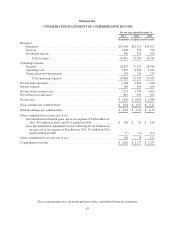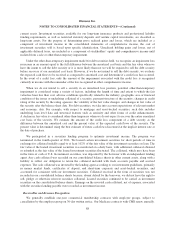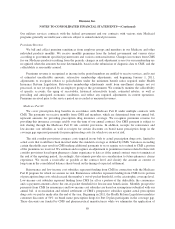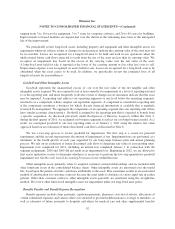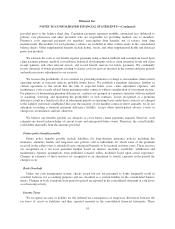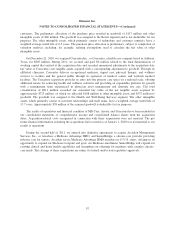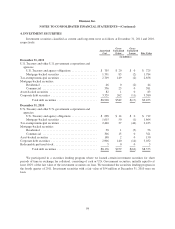Humana 2011 Annual Report Download - page 99
Download and view the complete annual report
Please find page 99 of the 2011 Humana annual report below. You can navigate through the pages in the report by either clicking on the pages listed below, or by using the keyword search tool below to find specific information within the annual report.Humana Inc.
NOTES TO CONSOLIDATED FINANCIAL STATEMENTS—(Continued)
Our military services contracts with the federal government and our contracts with various state Medicaid
programs generally are multi-year contracts subject to annual renewal provisions.
Premiums Revenue
We bill and collect premium remittances from employer groups and members in our Medicare and other
individual products monthly. We receive monthly premiums from the federal government and various states
according to government specified payment rates and various contractual terms. Changes in revenues from CMS
for our Medicare products resulting from the periodic changes in risk-adjustment scores for our membership are
recognized when the amounts become determinable, based on the submission of diagnosis data to CMS, and the
collectibility is reasonably assured.
Premiums revenue is recognized as income in the period members are entitled to receive services, and is net
of estimated uncollectible amounts, retroactive membership adjustments, and beginning January 1, 2011,
adjustments to recognize rebates to policyholders under the minimum benefit ratios required under Health
Insurance Reform Legislation. Retroactive membership adjustments result from enrollment changes not yet
processed, or not yet reported by an employer group or the government. We routinely monitor the collectibility
of specific accounts, the aging of receivables, historical retroactivity trends, estimated rebates, as well as
prevailing and anticipated economic conditions, and reflect any required adjustments in current operations.
Premiums received prior to the service period are recorded as unearned revenues.
Medicare Part D
We cover prescription drug benefits in accordance with Medicare Part D under multiple contracts with
CMS. The payments we receive monthly from CMS and members, which are determined from our annual bid,
represent amounts for providing prescription drug insurance coverage. We recognize premiums revenue for
providing this insurance coverage ratably over the term of our annual contract. Our CMS payment is subject to
risk sharing through the Medicare Part D risk corridor provisions. In addition, receipts for reinsurance and
low-income cost subsidies as well as receipts for certain discounts on brand name prescription drugs in the
coverage gap represent payments for prescription drug costs for which we are not at risk.
The risk corridor provisions compare costs targeted in our bids to actual prescription drug costs, limited to
actual costs that would have been incurred under the standard coverage as defined by CMS. Variances exceeding
certain thresholds may result in CMS making additional payments to us or require us to refund to CMS a portion
of the premiums we received. We estimate and recognize an adjustment to premiums revenue related to these risk
corridor provisions based upon pharmacy claims experience to date as if the annual contract were to terminate at
the end of the reporting period. Accordingly, this estimate provides no consideration to future pharmacy claims
experience. We record a receivable or payable at the contract level and classify the amount as current or
long-term in the consolidated balance sheets based on the timing of expected settlement.
Reinsurance and low-income cost subsidies represent funding from CMS in connection with the Medicare
Part D program for which we assume no risk. Reinsurance subsidies represent funding from CMS for its portion
of prescription drug costs which exceed the member’s out-of-pocket threshold, or the catastrophic coverage level.
Low-income cost subsidies represent funding from CMS for all or a portion of the deductible, the coinsurance
and co-payment amounts above the out-of-pocket threshold for low-income beneficiaries. Monthly prospective
payments from CMS for reinsurance and low-income cost subsidies are based on assumptions submitted with our
annual bid. A reconciliation and related settlement of CMS’s prospective subsidies against actual prescription
drug costs we paid is made after the end of the year. Beginning in 2011, the Health Reform Legislation mandates
consumer discounts of 50% on brand name prescription drugs for Part D plan participants in the coverage gap.
These discounts are funded by CMS and pharmaceutical manufacturers while we administer the application of
89






